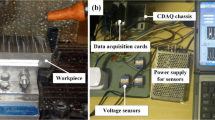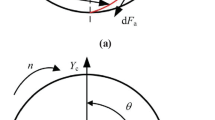Abstract
In nowadays, improve energy efficiency in the metal cutting industry is one of the main challenges. The selection of machining parameters and cooling/lubrication conditions is an important issue to assure better energy efficiency in the milling process. The present study explores the influence of three cutting parameters, namely, cooling/lubrication conditions, cutting speed and feed rate, on the energy consumption at ball-end end milling of Ti6-Al4-V. The main goal of this study is to increase the energy efficiency of the ball-end end milling process. To achieve this goal, techniques such as optimization and prediction of energy efficiency were used. The energy efficiency of the cutting process is defined through the specific energy consumption (SEC). In order to measure the total cutting power required to calculate the SEC, experiments were carried out in MQL and cryogenic conditions according to Taguchi’s L36 orthogonal array. Also, the Taguchi method was used to optimize the energy efficiency of this cutting process. The signal-to-noise ratio was applied to find the optimal levels of the cutting parameters to get the lowest value of SEC. Analysis of variance was employed to estimate the significance of control factors affecting SEC and to determine the experimental error. Finally, polynomial regression was utilized to formulate a mathematical model of the specific energy consumption.




Similar content being viewed by others
References
Liu, Z. Y., Guo, Y. B., Sealy, M. P., & Liu, Z. Q. (2016). Energy consumption and process sustainability of hard milling with tool wear progression. Journal of Materials Processing Technology, 229, 305–312. https://doi.org/10.1016/j.jmatprotec.2015.09.032
Sebastian, T. (2012). Energy efficiency in manufacturing systems. Sustainable production, life cycle engineering and management. Heidelberg: Springer.
Hong, M.-P., Kim, W.-S., Sung, J.-H., Kim, D.-H., Bae, K.-M., & Kim, Y.-S. (2018). High-performance eco-friendly trimming die manufacturing using heterogeneous material additive manufacturing technologies. International Journal of Precision Engineering and Manufacturing-Green Technology, 5(1), 133–142. https://doi.org/10.1007/s40684-018-0014-9
Perdomo, I. L. F., Quiza, R., Haeseldonckx, D., & Rivas, M. (2020). Sustainable-focused multi-objective optimization of a turning process. International Journal of Precision Engineering and Manufacturing-Green Technology, 7, 1009–1018. https://doi.org/10.1007/s40684-019-00122-4
IEA. 2020. Data and statistics. Paris, France: International Energy Agency. Accessed December 12, 2020, from https://www.iea.org/data-and-statistics?country=WORLD&fuel=Energy%20consumption&indicator=Total%20final%20consumption%20(TFC)%20by%20sector
Yi, Q., Ji, Q., Zhu, D., Jin, Y., & Li, L. (2020). Design optimization of lathe spindle system for optimum energy efficiency. Journal of Cleaner Production. https://doi.org/10.1016/j.jclepro.2019.119536
Cai, W., Liu, F., Zhou, X., & Xie, J. (2016). Fine energy consumption allowance of workpieces in the mechanical manufacturing industry. Energy, 114, 623–633. https://doi.org/10.1016/j.energy.2016.08.028
Hu, L., Peng, C., Evans, S., Peng, T., Liu, Y., & Tang, R. (2017). Minimizing the machining energy consumption of a machining tool by sequencing the features of a part. Energy, 121, 292–305. https://doi.org/10.1016/j.energy.2017.01.039
Xiao, Q., Li, C., Tang, Y., Li, L., & Li, L. (2019). A knowledge-driven method of adaptively optimizing process parameters for energy efficient turning. Energy, 166, 142–156. https://doi.org/10.1016/j.energy.2018.09.191
Rajemi, M.F. (2011). Energy analysis in turning and milling. Ph.D. thesis. The University of Manchester, Manchester.
Gutowski, T., Dahmus, J., Thiriez, A. (2006). Electrical energy requirements for manufacturing processes. In 13th CIRP international conference on life cycle emgineering, Leuven, Belgium (pp. 623–627).
Wang, H., Zhong, R. Y., Liu, G., Mu, W. L., Tian, X., & Leng, D. (2019). An optimization model for energy-efficient machining for sustainable production. Journal of Cleaner Production, 232, 1121–1133. https://doi.org/10.1016/j.jclepro.2019.05.271
Yoon, H. S., Kim, E. S., Kim, M. S., Lee, J. Y., & Lee, B. G. (2015). Towards greener machine tools—a review on energy saving strategies and technologies. Renewable and Sustainable Energy Reviews., 48, 870–891. https://doi.org/10.1016/j.rser.2015.03.100
Zhang, H., Deng, Z., Fu, Y., Wan, L., & Liu, W. (2017). Optimization of process parameters for minimum energy consumption based on cutting specific energy consumption. Journal of Cleaner Production, 166, 1407–1414. https://doi.org/10.1016/j.jclepro.2017.08.022
Wang, W., Tian, G., Chen, M., Tao, F., Zhang, C., Al-Ahmari, A., Li, Z., & Jiang, Z. (2020). Dual-objective program and improved artificial bee colony for the optimization of energy-conscious milling parameters subject to multiple constraints. Journal of Cleaner Production. https://doi.org/10.1016/j.jclepro.2019.118714
Moreira, L. C., Li, W. D., Lu, X., & Fitzpatrick, M. E. (2019). Energy-efficient machining process analysis and optimisation based on BS EN24T alloy steel as case studies. Robotics and Computer Integrated Manufacturing, 58, 1–12. https://doi.org/10.1016/j.rcim.2019.01.011
Zhou, L., Li, J., Li, F., Mendis, G., & Sutherland, J. W. (2018). Optimization parameters for energy efficiency in end milling. Procedia CIRP, 69, 312–317. https://doi.org/10.1016/j.procir.2017.12.005
Nguyen, T.-T., Mia, M., Dang, X.-P., Le, C.-H., & Packianather, M. S. (2019). Green machining for the dry milling process of stainless steel 304. Proceedings of the Institution of Mechanical Engineers, Part B Journal of Engineering Manufacture, 234, 881–899. https://doi.org/10.1177/0954405419888126
Yan, J., & Li, L. (2013). Multi-objective optimization of milling parameters—the trade-offs between energy, production rate and cutting quality. Journal of Cleaner Production, 52, 462–471. https://doi.org/10.1016/j.jclepro.2013.02.030
Wang, Y. C., Kim, D. W., Katayama, H., & Hsueh, W. C. (2018). Optimization of machining economics and energy consumption in face milling operations. International Journal of Advanced Manufacturing Technology, 99, 2093–2100. https://doi.org/10.1007/s00170-018-1848-6
Campatelli, G., Lorenzini, L., Scippa, A., Gianni, C., Lorenzo, L., & Antonio, S. (2014). Optimization of process parameters using a response surface method for minimizing power consumption in the milling of carbon steel. Journal of Cleaner Production, 66, 309–316. https://doi.org/10.1016/j.jclepro.2013.10.025
Zhang, H., Deng, Z., Fu, Y., Lv, L., & Yan, C. (2017). A process parameters optimization method of multi-pass dry milling for high efficiency, low energy and low carbon emissions. Journal of Cleaner Production, 148, 174–184. https://doi.org/10.1016/j.jclepro.2017.01.077
Nguyen, T.-T. (2019). Prediction and optimization of machining energy, surface roughness, and production rate in SKD61 milling. Measurement, 136, 525–544. https://doi.org/10.1016/j.measurement.2019.01.009
Wang, B., Liu, Z., Song, Q., Wan, Y., & Shi, Z. (2016). Proper selection of cutting parameters and cutting tool angle to lower the specific cutting energy during high speed machining of 7050-T7451 aluminum alloy. Journal of Cleaner Production, 129, 292–304. https://doi.org/10.1016/j.jclepro.2016.04.071
Zhang, L., Zhang, B., Bao, H., & Huang, H. (2018). Optimization of cutiing parameters for minimizing environmental impact: Considering energy efficiency, noise emission and economic dimension. International Journal of Precision Engineering and Manufacturing, 19, 613–624. https://doi.org/10.1007/s12541-018-0074-3
Chen, X., Li, C., Jin, Y., & Li, L. (2018). Optimize of cutting parameters with a sustainable consideration of electrical energy and embodied energy of materials. International Journal of Advanced Manufacturing Technology, 96, 775–788. https://doi.org/10.1007/s00170-018-1647-0
Albertelli, P., Keshari, A., & Matta, A. (2016). Energy oriented multi cutting parameter optimization in face milling. Journal of Cleaner Production, 137, 1602–1618. https://doi.org/10.1016/j.jclepro.2016.04.012
Chen, X., Li, C., Tang, Y., Li, L., Du, Y., & Li, L. (2019). Integrated optimization of cutting tool and cutting parameters in face milling for minimizing energy footprint and production time. Energy, 175, 1021–1037. https://doi.org/10.1016/j.energy.2019.02.157
Li, C., Xiao, Q., Tang, Y., & Li, L. (2016). A method integrating Taguchi, RSM and MOPSO to CNC machining parameters optimization for energy saving. Journal of Cleaner Production, 135, 263–275. https://doi.org/10.1016/j.jclepro.2016.06.097
Han, F., Li, L., Cai, W., Li, C., Deng, X., & Sutherland, W. J. (2020). Parameters optimization considering the trade-off between cutting power and MRR based on linear decreasing particle swarm algorithm in milling. Journal of Cleaner Production. https://doi.org/10.1016/j.jclepro.2020.121388
Li, C., Chen, X., Tang, Y., & Li, L. (2017). Selection of optimum parameters in multi-pass face milling for maximum energy efficiency and minimum production cost. Journal of Cleaner Production, 140, 1805–1818. https://doi.org/10.1016/j.jclepro.2016.07.086
Khan, A., Jamil, M., Salonitis, K., Sarfraz, S., Zhao, W., He, N., et al. (2019). Multi-objective optimization of energy consumption and surface quality in nanofluid SQCL assisted face milling. Energies. https://doi.org/10.3390/en12040710
Jang, D.-Y., Jung, J., & Seok, J. (2016). Modeling and parameter optimization for cutting energy reduction in MQL milling process. International Journal of Precision Engineering and Manufacturing-Green Technology, 3, 5–12. https://doi.org/10.1007/s40684-016-0001-y
Jamil, M., Zhao, W., He, N., Kumar, M. G., Sarikaya, M., Khan, A. M., Sanjay, M. R., Siengchin, S., & Pimenov, D. Y. (2021). Sustainable milling of Ti-6Al-4V: A trade-off between energy efficiency, carbon emission and machining characteristics under MQL and cryogenic environment. Journal of Cleaner Production. https://doi.org/10.1016/j.jclepro.2020.125374
Albertelli, P., & Monno, M. (2021). Energy assessment of different cooling technologies in Ti-6Al-4V milling. International Journal of Advanced Manufacturing Technology, 112, 3279–3306. https://doi.org/10.1007/s00170-020-06575-1
Quintana, G., Ciurana, J., & Ribatallada, J. (2010). Surface roughness generation and material removal rate in ball end milling operations. Materials and Manufacturing Processes, 25(6), 386–398. https://doi.org/10.1080/1539445090299660
Iqbal, A., Suhaimi, H., Zhao, W., Jamil, M., Nuaman, M. M., He, N., & Zaini, J. (2020). Sustainable milling of Ti-6Al-4V: Investigating the effects of milling orientation, cutter’s helix angle, and type of cryogenic coolant. Metals, 10(251), 1–25. https://doi.org/10.3390/met10020258
Hanafi, I., Khamlich, A., Cabrera, M. F., Almansa, E., & Jabbouri, A. (2012). Optimization of cutting conditions for sustainable machining of PEEK-CF30 using TiN tools. Journal of Cleaner Production, 33, 1–9. https://doi.org/10.1016/j.jclepro.2012.05.005
Author information
Authors and Affiliations
Corresponding author
Ethics declarations
Conflict of interest
No conflict of interest exists for all participating authors.
Additional information
Publisher's Note
Springer Nature remains neutral with regard to jurisdictional claims in published maps and institutional affiliations.
Rights and permissions
About this article
Cite this article
Tesic, S., Cica, D., Borojevic, S. et al. Optimization and Prediction of Specific Energy Consumption in Ball-End Milling of Ti-6Al-4V Alloy Under MQL and Cryogenic Cooling/Lubrication Conditions. Int. J. of Precis. Eng. and Manuf.-Green Tech. 9, 1427–1437 (2022). https://doi.org/10.1007/s40684-021-00413-9
Received:
Revised:
Accepted:
Published:
Issue Date:
DOI: https://doi.org/10.1007/s40684-021-00413-9




